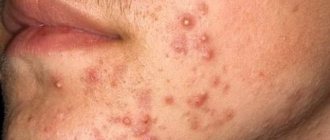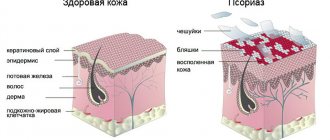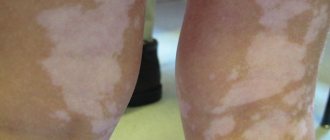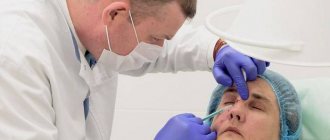Total alopecia: causes, treatment, prevention
The name of this disease – total alopecia – speaks for itself. Unlike other types of baldness, with this type of disorder, hair loss occurs everywhere and completely. This means that hair follicles are affected not only on the head, but also on the entire body, including facial hair (with total alopecia in men), eyelashes and eyebrows.
Total alopecia can affect both adults of both sexes and children. The nature of disease progression may also vary. In some cases, hair loss occurs so intensely that all of it can fall out within literally two to three months. Sometimes this process is more extended over time. In addition, there is also the concept of subtotal alopecia, when only what is called full hair falls out, but a small fluff of fine hairs may remain.
But no matter how intense the hair loss, one thing is clear - the need to clearly understand the causes of total alopecia. This will make it possible to take adequate measures to improve the patient’s condition and, possibly, prevent complete loss of hair.
This is important to do not only for health reasons. Baldness is generally difficult to experience psychologically, especially when it comes to total alopecia in women. It seriously affects a person’s appearance, which directly affects his self-esteem and sense of comfort in society.
At-risk groups
Total alopecia is most often observed in representatives of the stronger sex. However, this does not mean that the disease does not occur among the female part of the population.
And yet, in women, alopecia of this type occurs less frequently than in men due to the physiological structure of the scalp.
Hair follicles in women are located in deeper layers of the skin than in men, which contributes to their greater protection from the effects of negative factors.
Total alopecia develops in people regardless of age . There are cases of complete hair loss in children (for certain reasons).
Symptoms
A clinically important symptom of alopecia is hair loss. Pathology manifests itself both in the form of small focal lesions and in the form of rapid loss of entire hair.
The symptoms of baldness depend on the form and type of the disease.
The focal form is accompanied by local hair loss, with round or oval areas of baldness.
The affected area increases significantly over time.
Hair growing at the edges of the lesions becomes thinner and brittle. Signs of vitiligo and onychodystrophy are added to the symptoms.
After a few months, new hair appears in place of the lost hair, which will also fall out in a couple of weeks, and the balding areas will become even larger. Alopecia will take on a total form, involving eyelashes and eyebrows in the pathology.
Ophiasis, as a form of baldness, begins with the appearance of lesions whose skin surface is smooth and shiny. The baldness zones are ribbon-like, with a large extent. The disease occurs as a malignant disease and develops against the background of dysfunction of the endocrine system. For example, it is typical for people suffering from hypothyroidism or adrenal insufficiency.
With traumatic total alopecia, no pronounced symptoms are observed; areas where hair is completely absent are located next to areas covered with intact hair.
Significant sign of baldness in men
Symptoms of hereditary alopecia are more common in children. When studying the hair structure, follicular atrophy is noted in any area of the skin.
A characteristic sign of hereditary baldness is the presence of the disease in several family members. Androgenetic alopecia is characterized by rapid progression, usually hair loss begins in the forehead area, and then the problem spreads to the crown and back of the head.
Diagnostics
If signs of total alopecia are detected, the patient consults a trichologist . To make an accurate diagnosis, the doctor uses various diagnostic methods.
The patient is advised to take a blood test for hormone levels and undergo phototrichoscopy, which allows one to assess the condition of the hair follicles.
In addition, the doctor evaluates the history of illnesses suffered by the patient (it is quite possible that the cause of total baldness lies in one of them).
If the cause of alopecia is genetic factors , in which the patient has a complete absence of hair follicles (or their dysfunction, insufficient degree of development), diagnosing the disease does not make sense, since the cause of the disease is more than clear.
How is diagnosis and treatment carried out?
It is difficult to confuse an area of skin with alopecia areata with another pathology. The doctor makes a diagnosis based on a visual examination. If necessary, he can examine the hair near the balding area under a microscope. Before starting treatment, a specialist examines the condition of the body to clarify the possible cause of the disease. Treatment methods are selected individually for each patient. What they use:
- Sedatives and antidepressants.
- Drugs that improve cerebral circulation (Nootropil, etc.).
- Anti-inflammatory drugs and antibiotics in the presence of foci of chronic infection.
- Complexes of vitamins and minerals.
- Local treatment includes the use of ointments and creams that contain heparin and improve blood circulation. For autoimmune processes, the use of hormonal ointments is justified.
- Physiotherapy (electrophoresis, magnetic therapy, darsonval, etc.).
At home, tinctures and lotions are prepared based on locally irritating substances, such as red pepper, garlic or black radish. In severe cases, a hair follicle transplant or a wig may be necessary. The prognosis for alopecia areata is favorable; in most patients it goes away on its own or after treatment. It is more difficult for those patients whose disease proceeds with constant relapses and becomes a total or universal form.
https://youtube.com/watch?v=No4JyQIpTTk
Reasons for development
Unfortunately, the exact reasons that lead to the development of total baldness have not been fully established. However, most experts believe that factors such as:
- Heredity . In some cases, the child has insufficient development (or complete absence) of hair follicles from birth. Accordingly, the necessary conditions for the formation of hair are absent.
- Dysfunction of the immune system leads to disruption of the hair follicles and their weakening.
- Unfavorable living conditions (for example, poor ecology).
- Extensive injuries to the scalp (for example, extensive burns or frostbite).
- Hormonal disorders (in particular, increased levels of dihydrotestosterone, which negatively affects the condition of the hair follicles).
- Some infectious and non-infectious diseases (oncology, fungal infections, disorders of the circulatory and endocrine systems), inflammatory processes.
- Pathological conditions during pregnancy (for example, severe toxicosis).
- Previously transferred operations .
- Intoxication of the body caused by the negative effects of chemicals and radioactive substances.
- Poor nutrition (diets that exclude the intake of protein foods).
- Disorders in the functioning of the nervous system.
Read the following articles on our website about the types of alopecia:
- Telogen effluvium hair loss - what is it? Is treatment used for this type of alopecia?
- How difficult is it to cure cicatricial alopecia and what are the features of this disease?
- the main causes, signs and treatments of androgenetic alopecia or androgenetic alopecia;
- diffuse hair loss: how to recognize and eliminate such alopecia?
- unpredictable disease - alopecia areata.
Video: how to treat alopecia with hair transplant
Any changes we see in your hair must be very large. This is one of the first signs that something is happening in the body's body. Look for hair, its increased lightness and fragility can be caused by tension and poor eating habits. This is the first sign of internal organ disease. Therefore, it is never a mistake to find the right specialist.
The lack of iron causes not only anemia, but also disturbances in energy metabolism, since it is part of the enzymes involved in the oxidative reactions that the body generates energy sources. Lack of solution can cause hair loss and hair loss and increase shine. In addition, the lack of zinc, iodine and many others, which are necessary for the synthesis of testosterone and hormonal metalloproteinase, leads to hair density and growth properties.
Total alopecia is diagnosed in every 12 men, regardless of age, general condition of the body and the presence of bad habits.
However, this does not mean that the problem does not affect women.
Trichologists and dermatologists believe that complete baldness is provoked by a number of factors, among which genetic predisposition is considered the most significant - hair is lost due to a high concentration of dihydrotestosterone in the blood. Dihydrotestosterone is a male reproductive hormone.
According to tradition, traditional Indian medicine is a harbinger of inadequate growth and property of a few. Firstly, these are disorders of the kidney and liver organ systems, especially their weakening. There are problems with the blood system and energy flow. The purpose of the law is to harmonize the body as a whole, to harmonize the energy of yang and yen. Here we achieve very good results, especially with acupuncture, training and adjusting the dietary regime, including the addition of unsuccessful fruits.
Many drugs experience their “second youth”. These include, in particular. minoxidil, a pyrimidine derivative that was once used to treat severe hypertension. After the launch of new, safer antihypertensive drugs for patients, which are better tolerated and cause fewer side effects, minoxidil was withdrawn from the treatment of hypertension. His second chance came in external hair loss treatments. Local application of minoxidil preparations to the hairy scalp leads to dilation of blood vessels and improved blood flow to the hair follicles.
What does the term “total alopecia” mean?
This is a pathological condition, the result of which is complete baldness not only on the head, but also on other parts of the body: eyebrows, eyelashes, armpits, groin, pubis, limbs.
Alopecia affects not only adults, but also children. It progresses very quickly; within 3-4 months the patient may become completely bald.
Minoxidil stimulates the proliferation of hair follicle cells and the secretion of vascular endothelial growth factor and the synthesis of certain prostaglandins, which promote hair regrowth. These qualities have made minoxidil a very important place in the treatment of androgenic hair loss.
Androgenetic alopecia is the most common cause of human hair loss. Men show gradual hair loss starting from the temples and the tip of the head, but rarely leads to complete elimination. For women with subsequent diffuse thinning of hair throughout the scalp, one of the first visible signs of hair loss is the apparent widening of the compartments during combing. Androgenetic alopecia accounts for almost 95% of all hair loss cases, and its causes are not yet fully understood.
Even if total alopecia can be successfully treated, the process is long, requiring at least several years of recovery and recovery.
Hair falls out at different rates and in different places. The scalp immediately suffers, then the face.
- Total alopecia
- a person loses all hair on his head, eyebrows, eyelashes, and beard (if he is a man). - Subtotal baldness
- progresses very slowly, affecting only the guard hairs on the head. Vellus hair remains viable (on the back of the head and temples). Eyebrows and eyelashes only partially fall out. - Universal total alopecia
- hair loss all over the body, nails become thinner.
Signs
The main sign of total baldness is intense hair loss . First, patients notice thinning of the scalp, a decrease in the amount of hair (you can often see smooth scalp between the strands).
The hair becomes thinner, similar to fluff, which, if baldness treatment is not started, also falls out over time.
Diet for alopecia
You can stop alopecia by adjusting your diet
In the initial stages, you can prevent further hair loss by adjusting your diet.
It is necessary to ensure that the body receives a sufficient amount of proteins and essential amino acids. To do this, you must include in your menu meat (preferably low-fat varieties), seafood, fish, caviar, dairy products, cheeses, cottage cheese, eggs.
No less important for hair health are fatty acids that are present in vegetable oils (olive, sunflower, flax seeds, etc.)
Micro- and macronutrient deficiencies should also be avoided. To compensate for the lack of zinc in the body, which often causes baldness, you need to eat more legumes, beef, pork, liver, buckwheat, oatmeal, turkey, pine nuts and peanuts. Hair loss can also begin due to selenium deficiency. To eliminate it, you need to add more seafood, rice, corn, and eggs to your diet.
Stages of the disease
Total alopecia is the last stage of focal baldness. There are 3 main stages of this disease:
- A sharp decrease in the amount of hair on the scalp.
- Thinning of hair, change in its quality (instead of healthy hair, thin fluff appears on the patient’s scalp).
- Total (complete) hair loss.
Read about the main stages of alopecia, according to Norwood’s classification of degrees of baldness, here.
Forms of focal baldness
The diffuse form causes scalp baldness. With the subtotal form, about forty percent of hair falls out. During ophialis, hair falls out in certain areas of the head. The marginal zone is most often affected by this form of the disease. It is extremely rare that the disease affects the temporal, occipital or frontal regions.
The total form of focal baldness causes hair loss on the entire surface of the head. And with universal hair loss, a person loses not only his entire head of hair, but also his body hair.
The onset and development of such a pathology is impossible to predict, since new lesions form after the old ones have healed, and the process cannot be stopped for decades. Therefore, treatment of alopecia areata in women and men gives very different results. The disease may develop in a severe form, with periodically changing types of the disease.
Ringworm alopecia is typical for people with mental disorders. In the parietal zone, the hair breaks off near the base and with a slight twitch falls out completely. But even in the absence of treatment, hair regrowth is possible within a few weeks.
Can alopecia totalis be cured?
What treatment methods for total baldness exist today? If the cause of baldness is a hormonal imbalance , treatment is carried out using hormonal drugs of the steroid group.
When metabolic processes in the scalp are disrupted, physiotherapeutic procedures are often used, for example, therapeutic massage, ultrasound. The same method can be used to strengthen hair follicles in other cases.
The autoimmune nature of the causes of baldness is an indication for the use of immunomodulatory drugs.
Their dosage and duration of treatment are determined only after consultation with an immunologist, as well as after assessing the results of a blood test that determines immune status.
The patient is prescribed a course of vitamin therapy, taking a complex of multivitamin preparations, which includes vitamins and minerals necessary for normal skin nutrition.
The diet should be adjusted to include a sufficient amount of protein products (eggs, lean meat, dairy products).
If these methods do not give a positive result, a radical method of treatment - hair follicle transplantation. Success is not guaranteed; it all depends on the characteristics of the donor material and the patient’s skin. You can find out more about modern transplant methods, including non-surgical techniques and the price of this procedure, on our website.
Important !
Treatment for total alopecia depends on which cause led to the problem. Only a doctor can determine this reason.
When is surgical hair extension used?
If the person wishes and there are no contraindications, surgical intervention is performed.
Bleeding disorders and allergic reactions to anesthesia are the main contraindications. The rest include:
- Follicle transplantation is prohibited for persons under 15 years of age. At this age, the area of the lesion is difficult to determine.
- For a number of psychological disorders, hair transplantation is not performed.
- If the patient suffers from skin diseases, especially at the development stage.
- Persons with cardiovascular diseases or oncology are recommended to have a preliminary consultation with a doctor.
- Patients with diabetes are at risk for post-operative infections.
A strip is cut out with a scalpel and the grafts that will be used for transplantation are removed. Special incisions are made into the affected area for hair transplantation.
The patient must be prepared for the appearance of a scar 15-20 cm long. Some experts argue that it will not be possible to achieve natural hair thickness, even if several operations are performed at once.
Total alopecia is a problem faced by men, women and even teenagers. It is important to identify the problem early, while the affected areas are not so large.
In favor of treatment, experts emphasize that the follicles do not die, which means there is a chance to resume the hair growth process. To do this, tests are taken to determine the causes of baldness. In the future, you need to monitor your own health to prevent a new manifestation of the problem.
Some patients decide to take a drastic step - a transplant operation, which should solve the problem once and for all. This procedure has certain contraindications that should be taken into account when choosing a solution to the problem of baldness.
Do traditional methods of treatment help?
Traditional medicine is often used as an addition to basic treatment methods, or as preventive measures to help prevent hair loss.
Traditional methods will only help strengthen the hair follicles (if they are absent, using these recipes is pointless). Here are some recipes:
- 1.2 tbsp. Mix gelatin with water until you obtain a paste consistency. Add a little colorless henna, the yolk of 1 egg. Apply the mask to your hair for 30 minutes. Rinse thoroughly. You can use this product 1-2 times a week.
- 2.1 tbsp. Mix mumiyo with 1 yolk and a teaspoon of honey. Apply to hair for half an hour (carefully distribute over the scalp and the entire length of the hair), rinse with water and shampoo.
Read on our website about effective masks against hair loss using: oak bark, sea and table salt, garlic, yeast, burdock oil, herbal decoctions, burdock infusions, hops.
Why do strands fall out?
Complete hair loss can occur from the influence of various factors on the human body. Most often, such violations are the consequence of a serious malfunction in the functioning of internal organs and their systems. But there may be other reasons, for example:
- Autoimmune diseases. When they occur, the immune system perceives the follicle as a foreign body and begins to attack it.
- Stress, nervous tension, overwork. With persistent psychoneurological disorders, spasm of blood vessels and tissues occurs. This causes disruption of blood circulation inside the hair follicle and further loss of strands.
- Heredity. Most often, this factor causes hair loss in men; it can be transmitted from older to younger generations. Genetically determined alopecia cannot be treated.
- Congenital follicular disorders. Such diseases are diagnosed in infants, usually in the first two years of life.
- Infectious and sexually transmitted diseases that have not been fully cured. In an advanced state, pathologies such as, for example, syphilis or tuberculosis, can cause total hair loss.
- Serious metabolic disorders. With this pathology, cells cannot fully absorb the beneficial substances they receive from the outside, which leads to weakening of the follicles and their euthanization.
- Anticancer therapy. Oncology can be treated with very aggressive methods. For example, radiation, chemotherapy, or taking strong medications. All this causes suppression of the activity of hair follicles.
- Excessive amounts of vitamins or their deficiency. With such violations, not only the hair suffers, but the entire body, and serious disruptions in its functioning are observed.
- Close contact with radioactive or chemical substances. It disrupts metabolic processes at the cellular level, therefore it certainly affects the density of curls.
Hair can also suffer from constant exposure to very cold or hot air. Extreme temperatures cause degenerative processes in the follicles, which causes complete loss of strands.
In any case, treatment for alopecia should begin by eliminating the cause of its appearance.
Possibility of relapse
Even successful, effective treatment (regardless of the methods) of total alopecia does not guarantee that the disease will not recur . The risk of relapse can be reduced only if the cause of baldness is completely eliminated.
Total alopecia is the final stage of focal type baldness. Despite the intensity of development, the disease can be cured by eliminating its main cause and using competent methods of therapy.
Of course, if we are talking about the congenital absence of hair follicles , traditional (as well as folk) methods are completely powerless; only transplantation will help.
Complications and consequences
Total alopecia takes a long time to be treated , which requires considerable physical and emotional strength. In the absence of a comprehensive response to the problem, baldness may worsen and spread to other areas of the body.
Advanced forms of the disease, which have complex causes, can cause a complete absence of hair on the head.
This requires a surgical approach in the treatment of alopecia, by transplanting healthy and capable bulbs.










